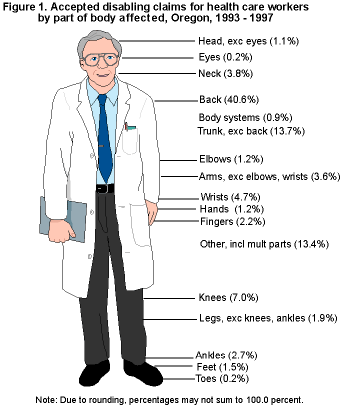
Since 1980, the Bureau of Labor and Statistics (BLS), has taken injury and illness readings in nursing homes and hospitals, the two largest employers of health service workers. Over the last five years, the nursing home industry has seen a decrease in lost workday cases incident rates1. In Oregon, the 1993 incidence rate of 9.2 in the nursing care facilities industry decreased 13.3 percent to 8.0 in 1997. In the hospital industry, the 1993 incident rate of 4.0 decreased slightly to 3.9 in 1997. This difference between the two industries reflects, for the most part, how caregivers carry out daily duties in the various health care settings.
Within nursing homes, for example, many patients require around-the-clock assistance with the basic activities of daily living, such as getting in and out of bed or bathing. Such physically demanding assistance, often carried out by nursing aides and orderlies, is less evident in hospitals which typically provide acute care rather than long-term care.
This report presents data about Oregon’s work-related injuries, illnesses, and fatalities to health care workers. It evaluates accepted disabling workers’ compensation claims during the years 1993-1997. Information on claims for all workers of all occupations can be found in the yearly publication entitled Oregon Workers’ Compensation Claims Characteristics.
In Oregon, a disabling claim involves more than three days of time loss, permanent disability, or inpatient hospitalization. An accepted claim means that a workers’ compensation insurer has determined that the condition is work-related and compensable. The claims that are not severe enough to be defined as disabling are not reported to the Workers’ Compensation Division (WCD). Therefore, this report includes only the most serious cases.
• From 1993-1997, a total of 8,202 disabling claims were accepted for health careworkers; eight of these claims were work-related fatalities.
• WCD received notification of 1,913 claims for health care workers in 1993. This number declined at an average rate of 124 claims per year to 1,417 claims in 1997.
• Fifty-five percent of health care workers injured were nursing aides; 18 percent were registered nurses.
• Sprains, strains, and tears accounted for 73 percent of injuries to health care workers. Fifty-nine percent of the sprains and strains were to nursing aides. • Back, the most common body part injured by health care workers, accounted for 41 percent of injuries.
• Overexertion caused 55 percent of injuries to health care workers.
• Other people, including health care patients, were the sources of injury to health care workers 52 percent of the time.
Injuries and Illnesses
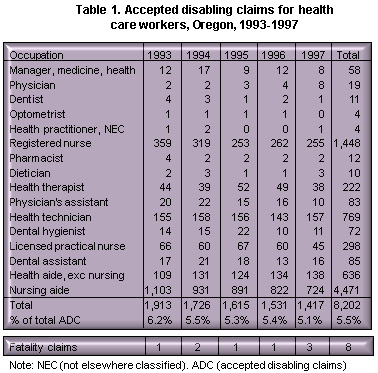 The
number of health care workers suffering occupational injuries
and illnesses has declined an average of 124 claims per year
since 1993, when WCD received notification of 1,913 accepted
disabling claims for health care workers. Compensable claims
averaged 1,640 per year during the five-year period from 1993-1997.
Fatalities averaged 1.6 per year (Table 1).
The
number of health care workers suffering occupational injuries
and illnesses has declined an average of 124 claims per year
since 1993, when WCD received notification of 1,913 accepted
disabling claims for health care workers. Compensable claims
averaged 1,640 per year during the five-year period from 1993-1997.
Fatalities averaged 1.6 per year (Table 1).
Table 1 shows health care occupations with the number of accepted disabling claims received by the Workers’ Compensation Division (WCD). Injuries to nursing aides have steadily decreased at an average of 95 claims a year with 1993 showing the highest amount of claims (1,103) during the five-year period from 1993-1997. Nursing aides accounted for 55 percent (4,471 claims) and registered nurses accounted for 18 percent (1,448 claims) of the 8,202 accepted claims during 1993-1997.
|
Industry division Hospitals in the health services industry accounted for 40 percent (3,300 claims) of the accepted disabling claims to health care workers (see Table 2). Eighty-six percent of the injured health care workers employed at nursing and personal care facilities were nursing aides, as were 37 percent of those employed at hospitals and 77 percent of those employed in residential care. For all health care injuries, 84 percent of the workers were in the private sector and 16 percent in the public sector. |
Overexertion was the most common event for most health care occupations. In hospitals, 61 percent of the injuries to registered nurses and 43 percent to health technicians were due to overexertion. Sixty-nine percent of the injuries to nursing aides in nursing and personal care facilities were overexertion injuries; these figures were 55 percent in hospitals, and 60 percent in residential care. Most of the overexertion injuries were caused by lifting, pushing/pulling, or holding/carrying of patients. |
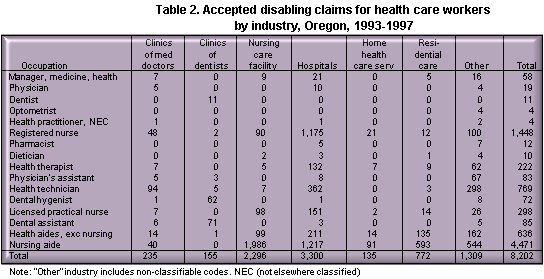
|
Accident event Overexertion resulted in the greatest number of claims for health care workers (4,544) during the five-year period from 1993-1997 (Table 3). Nursing aides suffered 54 percent of overexertion claims involving other people, including health care patients. Falls resulted in the second greatest number of job-related injuries to health care workers (1,040 claims), followed by violent acts and assaults (524 claims). Almost half of the falls occurred when nursing aides fell down stairs or fell to the same level, mostly to the floor, walkway, or ground surface. Seventy-one percent of the assaults were to nursing aides. |
Nature of injury Sprains, strains, and tears were the leading cause of job-related injuries to health care workers (5,977 claims) during 1993-1997 (Table 4). Of sprains, strains, and tears, nursing aides suffered 59 percent and registered nurses suffered 17 percent. Bruises and contusions resulted in the second greatest number of claims (371), followed by fractures (287 claims). Almost 70 percent of sprains, strains, and tears were caused by overexertion, followed by bodily reaction (9 percent). Twenty-six percent of the bruises and contusions and 11 percent of the fractures resulted when the worker was either struck by or against an object. |
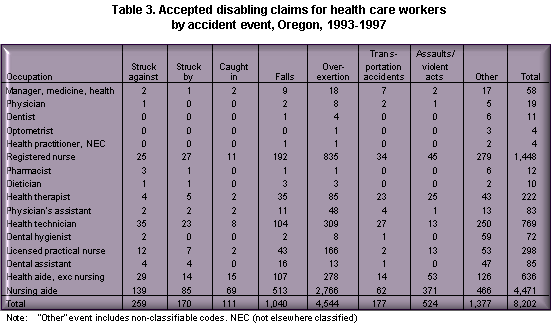
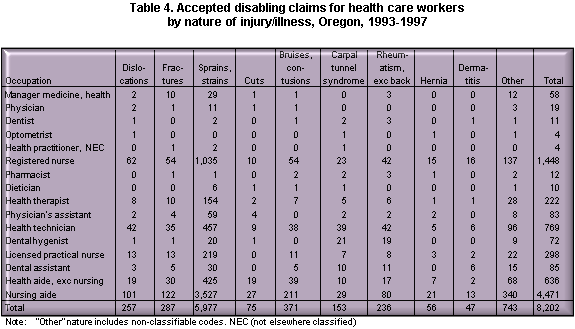
|
Part of body
|
|
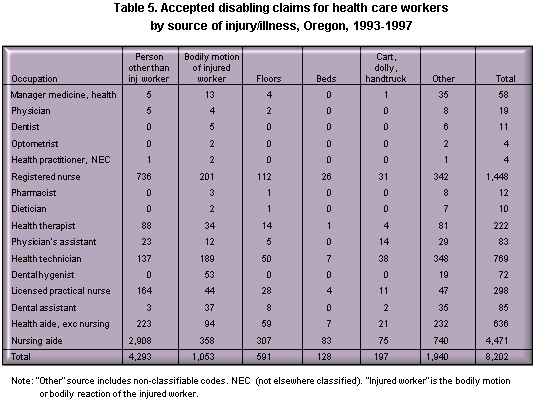
|
Gender and tenure Thirty-five percent of work-related injuries to health care workers occurred during the first year of employment (2,880 claims). There were considerably fewer claims during the second and third year of employment with an average of 820 claims per year during 1993-1997. |
Nursing aides accounted for 75 percent of the
injuries during the first year of employment. Fatalities From 1993 to 1997, the Workers’ Compensation Division of the Department of Consumer & Business Services recorded the acceptance of eight claims for fatally injured health care workers. Two of these fatal accidents were caused by a violent act: a health aide was stabbed and a nursing aide was shot. Of the eight fatalities, two were male. Table 6 lists the occupation of the worker and the description of the event that caused the fatality. |
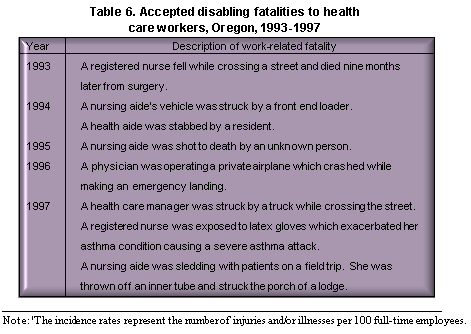
DCBS Home Page | IMD Home Page | Search
If you have questions about the information contained in this document please contact by e-mail or phone: Stacey Barnhart, Research Analyst, Research & Analysis Section, Information Management Division (503) 947-7367
Document URL: http://www.cbs.state.or.us/external/imd/rasums/3267.html
[Printed form: 440-3267 (10/99/IMD)]
In compliance with the Americans with Disabilities
Act (ADA), this publication is available in
alternative formats by calling (503) 378-4100 (V/TTY).
The information in IMD publications is in the public domain and may be reprinted without permission.
